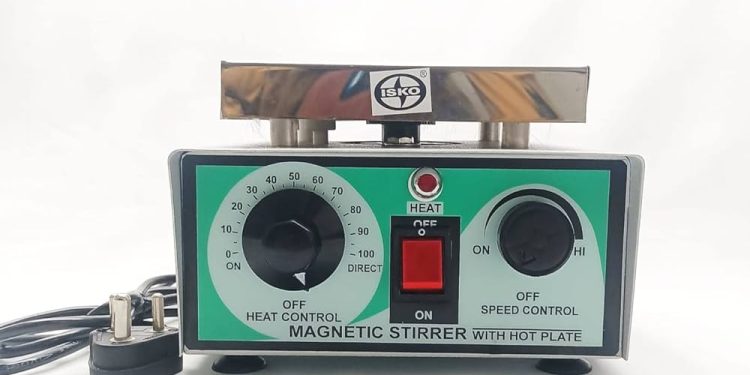Magnetic Stirrers: A Must-Have Lab Tool Explained

Reputable labs of today prioritize accuracy, efficiency, and safety. There are a few pieces of equipment that are eventually going to be needed in any lab, whether that is a pharmaceutical lab synthesizing pharmaceuticals, a university lab conducting some experiments, an industrial lab mixing chemicals, and so on. One of those pieces of equipment is a magnetic stirrer.
Magnetic stirrers are commonly used to mix liquids together and have now become standards in today’s lab methods. What are they, how do they work, and why are they so essential to life, whether that is one way or another? In this literature we will investigate how magnetic stirrers work, the advantages of using them, and the use in laboratories today.
What is a Magnetic Stirrer?
A magnetic stirrer is a laboratory device utilizing a stirring mechanism of a rotating magnetic field to stir liquids in a self-supporting manner. Typically it has a small bar magnet (commonly referred to as a “stir bar”) situated in a liquid vessel, with a rotating magnet or array of stationary electromagnets below the vessel. As the magnetic field tilts, the stir bar turns in the liquid vessel which agitates the liquid very efficiently.
This simple but very effective method eliminates hand stirring, while enabling consistency in mixtures. The work it does in producing sensitive products requiring constant, controlled stirring is very worth its weight.
Key Components and Types
Magnetic stirrers come in various forms depending on their use and complexity:
1. Basic Magnetic Stirrers
These are simple units designed for routine mixing tasks, especially when heating is not required. They’re compact, easy to operate, and ideal for light-duty lab work.
2. Magnetic Stirrer Hot Plate
When temperature control is essential, a magnetic stirrer hot plate comes into play. These devices combine stirring and heating functions in one unit, allowing for simultaneous mixing and heating of solutions. This is particularly useful in chemistry labs where temperature-sensitive reactions are common.
3. Hot Plate and Magnetic Stirrer Combo
Some models are designed as dual-function units where the hot plate and magnetic stirrer operate independently or together. This allows more flexibility for different experimental requirements.
4. Magnetic Mixer Hot Plate
The magnetic mixer hot plate is built for advanced applications, offering greater control over both temperature and stirring speed. These are often used in pharmaceutical or biochemical labs that require high precision.
Why Magnetic Stirrers Are Essential in Modern Laboratories
There are several reasons why magnetic stirrers have become a must-have in lab setups:
1. Consistent Mixing
Unlike manual stirring, magnetic stirrers offer uniform and repeatable mixing. This consistency ensures that test results are reliable, especially in quantitative experiments.
2. Time Efficiency
Automation saves time. Lab technicians can set the stirrer and focus on other tasks, improving overall productivity in the lab.
3. Minimized Contamination
Since the stirring mechanism is contained within the vessel, there’s minimal risk of external contamination. This is crucial in biological and chemical experiments where purity is a priority.
4. Safe Heating and Mixing
In devices such as the magnetic stirrer hot plate, heating and stirring are integrated into one compact unit. This reduces clutter and the possibility of spills or accidents from handling hot solutions.
5. Precise Control
Most modern magnetic stirrers also have variable temperature and speed controls. Whether you’re dissolving a solute slowly or maintaining a reaction at a specific temperature, you can set the controls accordingly.
6. Low Maintenance
With fewer moving parts compared to mechanical stirrers, magnetic stirrers are less prone to breakdown and require minimal maintenance.
Common Applications
Magnetic stirrers are widely used across various industries and disciplines. Here are some typical scenarios:
- Chemical Research: Most appropriate for reagent mixing and maintaining consistent conditions for the reactions to run.
- Pharmaceutical Labs: Used for drug formulation and for testing the quality of the products.
- Biology Labs: Used for cell cultures and prepared specimens.
- Schools/Universities: Standard in teaching chemistry and biology in schools and universities.
- Food and Beverage Testing: Perfect in quality control labs and formulation testing.
Choosing the Right Magnetic Stirrer
When selecting a magnetic stirrer for your lab, consider the following factors:
- Volume Capacity: Confirming that the stirrer has adequate volume capacity for the volume of liquid you routinely work with.
- Temperature Range: If you want to heat your solution, you should check the hottest temperature which can be achieved by the magnetic stirrer hot plate.
- Speed Control: Having variable speed settings provides more control with the stirring process.
- Material Compatibility: Check compatibility of stir bar and plate surface with your substances.
- Durability and Safety Features: Look for safety features such as non-slip surfaces, heat-resistant bodies, and auto shut-off.
Tips for Optimal Use
- Always center the stir bar in the container to ensure proper operation.
- Flat-bottomed containers will provide better contact with the stir plate.
- Clean the stir bar and plate after each use to prevent carry over contamination.
- Avoid using magnetic stirrers with very viscous solutions or solutions containing solid particles that could jam the bar.
Conclusion
As laboratory science develops, tools such as magnetic stirrers provide consistency, efficiency, and control to ensure experiments are accurate and safe. Whether you are heating a solution, maintaining a delicate reaction, or mixing different chemicals, hot plates and magnetic stirrers make a difference when properly selected.
For professionals looking for reliable lab equipment, chemical distributors in India offers a range of magnetic stirrers, including hot plate and mixer variants. Their products are designed to meet the rigorous demands of modern labs.






